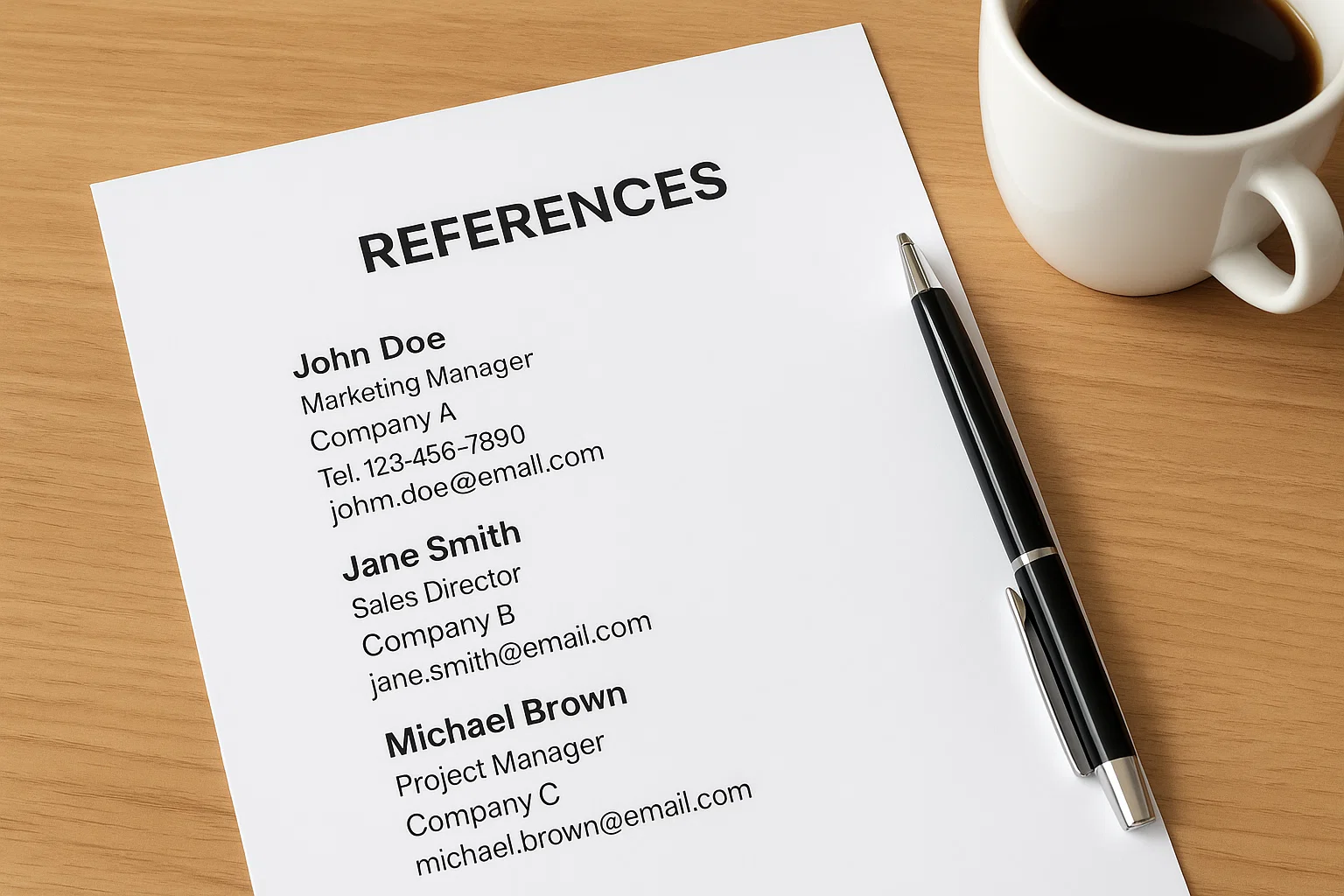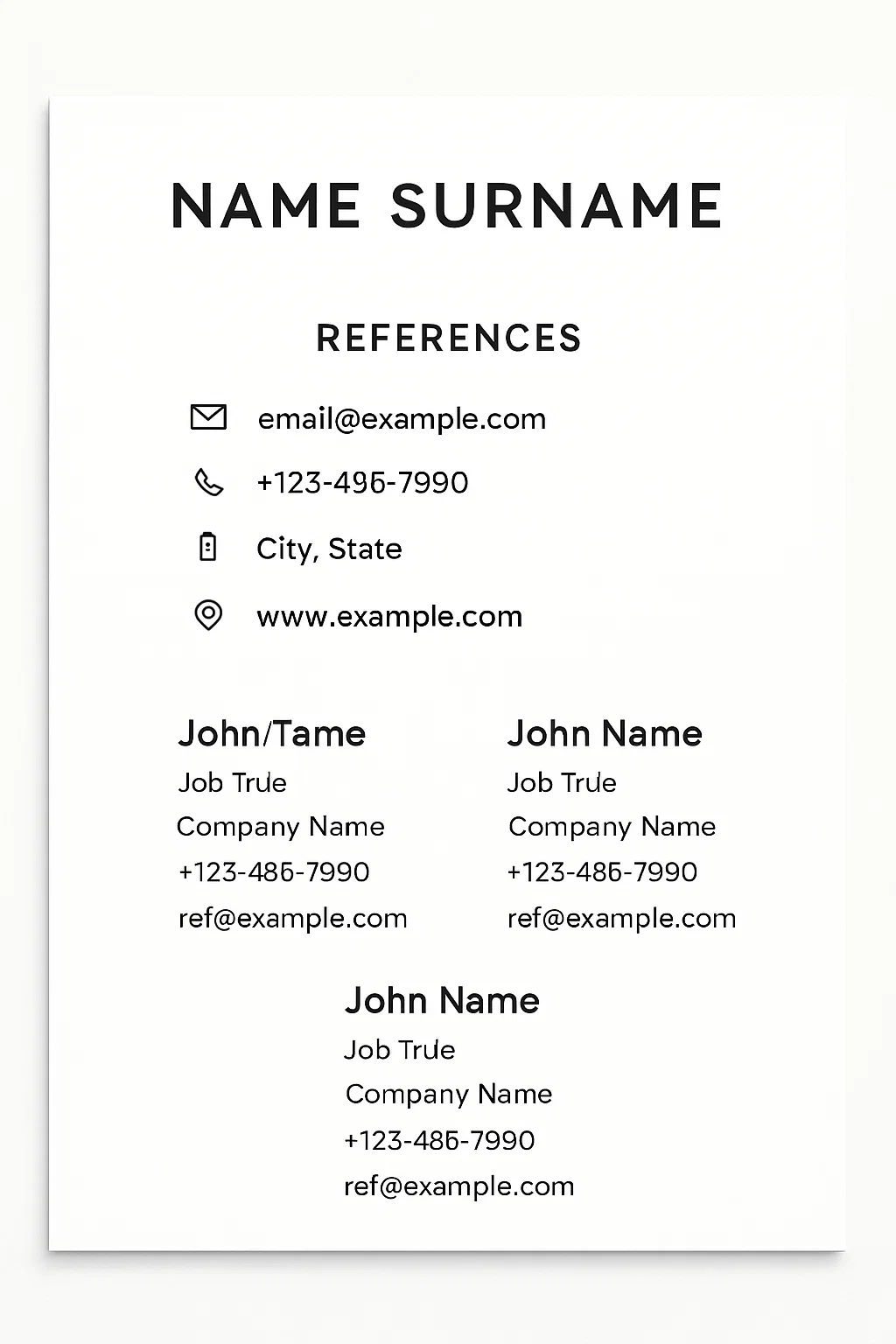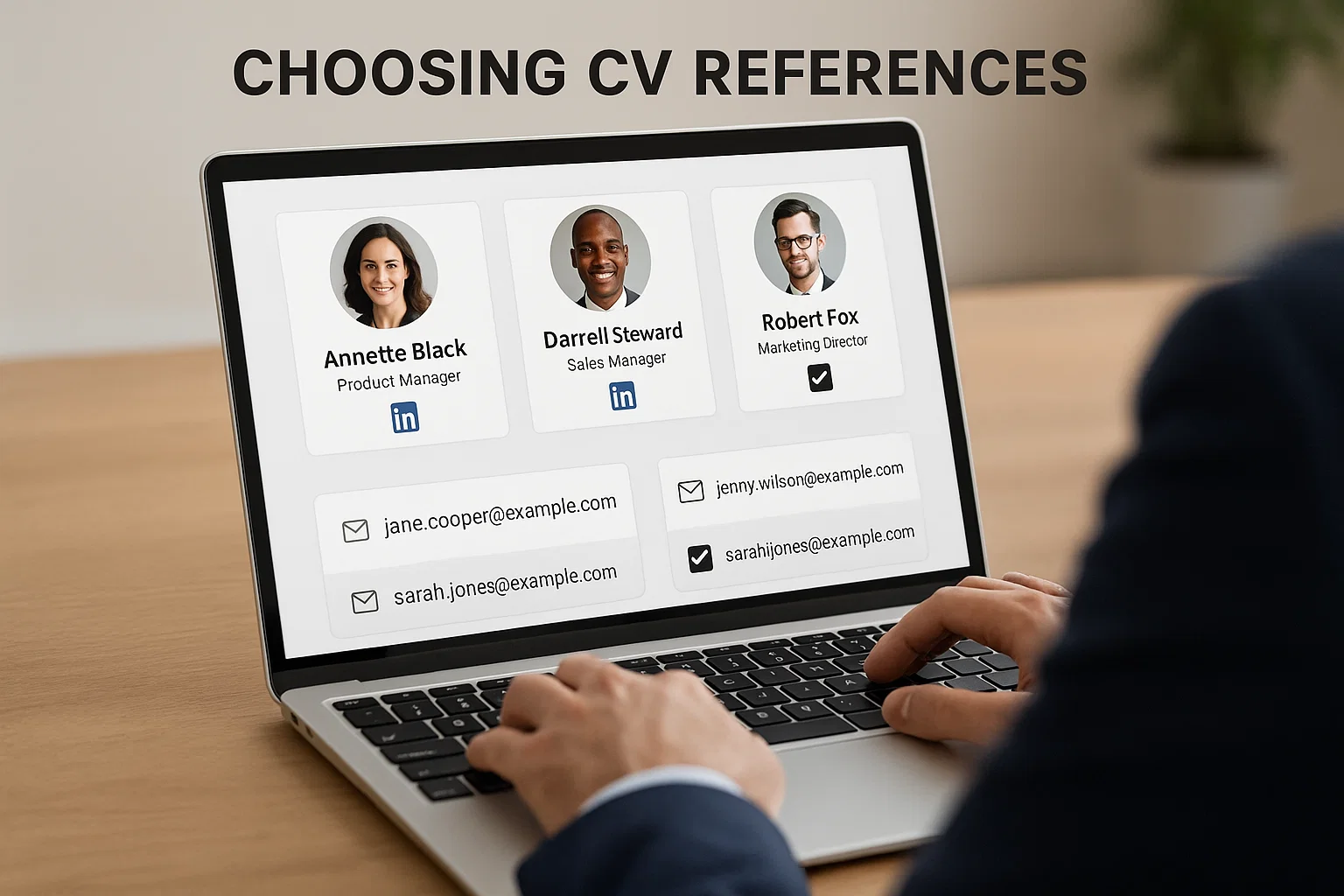A solid reference list shows you’re confident, organised, and genuinely good at what you do. A sloppy one? It makes recruiters raise an eyebrow. So let’s clean that up.
The Real Deal With CV References
You’ve probably heard mixed opinions about references. Some say they’re outdated, others swear by them. The truth? They’re still relevant but how you present them matters more than ever.
Employers rarely check references before the final round these days, but when they do, they expect professionalism. A strong reference list tells them:
- You’ve built good relationships.
- You left your previous job on great terms.
- Someone credible is ready to vouch for you.
Think of references as the final background check before trust. If your CV got you into the room, your references make sure you actually belong there.
Who Makes the Best Reference (And Who Doesn’t)
Here’s where most people mess up. They panic-add their cousin, a teacher from 2011, or their mate who “used to work in HR.” Not good.
The best references are people who can confidently talk about your work ethic, achievements, and character.
So who qualifies?
| Type | Best For | Example |
|---|---|---|
| Former Manager | Most valuable reference | “John Smith, Marketing Manager at XYZ Ltd.” |
| Supervisor/Team Lead | Specific skills or project performance | “Amira Ali, Project Lead, TechNova” |
| Senior Colleague | Collaboration & reliability | “James Cooper, Senior Engineer, BuildTech” |
| Mentor/Coach | Professional growth & attitude | “Dr. Sandra Lee, Career Mentor, UCL” |
| Client | Freelance credibility | “Lisa Reed, Creative Director, BrandSpark Agency” |
Avoid: family, friends, or anyone who hasn’t worked with you directly. HR managers can spot those instantly and it screams unprofessional.
If you’re new to the job market, go for professors, internship supervisors, or volunteer coordinators. They count, too.
How To Write CV References the Right Way
There’s a bit of art and structure involved here think clean, clear, and professional.
Here’s the basic reference format you can follow:
Now, here’s how it might look in real life:
Example (Simple Version)
Sophie Williams
Senior Content Editor, Bright Media Ltd.
📧 sophie.w@brightmedia.co.uk
📞 +44 7700 900123
Relationship: Former Manager
Example (Detailed Version)
David Hughes
Head of Digital Marketing, NovaTech Solutions
123 High Street, London, W1A 2BC
📧 d.hughes@novatech.com | 📞 +44 7900 556712
Relationship: Direct Supervisor (2021 – 2023)
Keep the format consistent. Fonts should match the rest of your CV, and spacing should look neat. No fancy colours or weird icons it’s not a design contest.
Should You Include References Directly on Your CV?
This one’s a classic debate. So here’s the no-nonsense answer:
If the employer specifically asks for references, include them.
If they don’t, just write “References available upon request.”
Simple.
Why? Because CVs have limited space and you’d rather fill it with achievements that get you noticed. Recruiters often check references after the interview stage anyway.
But if you’re applying to government roles, teaching jobs, or healthcare positions (where trust and background verification are vital), add at least two references upfront.
How To Ask Someone To Be Your Reference
Never, ever surprise someone with a reference call. It’s awkward for everyone.
Here’s the polite way to do it:
- Ask First Send a short, friendly message:
“Hey Sophie, I’m applying for a new role in content marketing and wondered if you’d be happy to provide a reference? I really appreciated working with you at Bright Media.” - Give Details Mention the job title and company so they know what to expect.
- Keep Them Updated Let them know when you’ve listed them and when potential calls might happen.
- Say Thanks Always follow up with a genuine thank-you email or message later.
It’s simple courtesy and it keeps your professional network warm for future opportunities.
Example Layout: Professional Reference Section
If you’re including references at the end of your CV, here’s how to format it.
Option 1 – Two References
References
1. Emily Davies
Marketing Director, Brandly Ltd.
📧 emily.d@brandly.com | 📞 +44 7400 888777
Relationship: Former Manager
2. Jason Brown
Senior Copywriter, Bright Media Ltd.
📧 jason.b@brightmedia.co.uk | 📞 +44 7400 223344
Relationship: Colleague & Team Partner
Option 2 – Reference Sheet (Separate Page)
If your CV already stretches to two pages, create a separate reference sheet with the same header style and your name at the top.
Attach it as “YourName – References.pdf.”
That’s clean, modern, and recruiter-friendly.
Pro Tips To Make Your References Work Harder For You
Let’s go beyond the basics because most applicants stop there.
- Pick People Who’ll Answer Calls
Sounds silly, but recruiters move fast. If your reference never replies, that silence can cost you the job. Choose responsive, reliable people. - Align Their Story With Yours
If your CV says you managed a project, make sure your referee remembers it the same way. A quick recap email helps:
“Just a heads-up I mentioned the SolarTech campaign we did together. They might ask about it.” - Update Old Referees
If you’re applying for something totally different, brief them on your current goals. It helps them tailor their feedback. - Don’t Overuse the Same References
Employers sometimes contact multiple references from your list. Rotate them occasionally it keeps your network fresh. - Check Their Contact Info
Outdated email addresses or wrong phone numbers make you look careless. Verify everything before sending. - Use a Consistent Format
Matching font, size, and layout these small things show attention to detail, which recruiters love. - Keep It Private (When Needed)
Never post your referees’ contact details on public job boards. Save that info for serious applications only.
What Employers Actually Check When They Call Your References
Most people assume reference calls are quick formality checks but employers dig deeper than that.
Here’s what they usually ask:
- Dates of employment and role verification
- Key strengths (and sometimes weaknesses)
- Work ethic, communication, and reliability
- How you handled pressure or conflict
- Would they rehire you? the question that says everything
A good reference doesn’t need to gush about you. They just need to sound confident, consistent, and honest.
How Many References Do You Need?
For most jobs, two to three references are ideal:
- One direct supervisor
- One colleague or team member
- Optional: a client, professor, or mentor
If you’re early in your career, two is fine. If you’ve been around longer, three adds credibility. More than that? Overkill.
Is It Okay to Put References on a CV?
Absolutely as long as it’s relevant and the person has agreed. Just remember:
- Don’t list references unless requested or industry-specific.
- Always ask permission first.
- Keep the layout professional and easy to read.
- Don’t overshare personal contact details if you’re uploading the CV publicly.
If in doubt, use a separate reference sheet. It looks cleaner and protects privacy.
How To Properly Put References on a Resume (Modern Style)
Modern CVs are minimalist. The trend is to keep things short and smart so here’s how to make your reference section look 2025-ready.
Spacing, alignment, and subtle typography are your friends. Don’t centre the text keep it left-aligned like the rest of your CV.
And yes, it’s fine to drop the full address these days; email and phone are enough.
When Not To Include References
Sometimes leaving them out is the smarter move.
Skip the reference section if:
- You’re submitting through an online form that has a separate reference field.
- You’re applying through LinkedIn (they already have recommendations visible).
- You haven’t informed your referees yet.
- You’re in an early application stage where HR only wants your CV.
Less is more don’t clutter your CV with extra info no one asked for.
Bonus: Email Template for Asking a Reference
Here’s a quick, polite message you can copy:
Subject: Request for Professional Reference
Hi [Name],
I hope you’re well! I’m applying for a new position as [a short job title] at [Company Name] and would be grateful if you could provide a reference for me.We worked together on [mention project or role], and I believe you could speak to my [skills/achievements].
I’ll include your name and contact details with my CV if you’re comfortable. Please let me know if that’s okay.
Thank you so much for your time and support!
Best,
[Your Name]
Keep it short, friendly, and clear. Most professionals are happy to help if you make it easy for them.
Common Mistakes To Avoid
Let’s run through the pitfalls quickly because even great candidates trip here:
- ❌ Listing people without asking first
- ❌ Using references who barely remember you
- ❌ Typos in email addresses or phone numbers
- ❌ Mixing personal and professional contacts
- ❌ Writing “References available upon request” in every single job app (save it for relevant ones)
- ❌ Including references on a public CV upload protect your referees’ privacy
When You Have No References (Yet)
If you’re new to the workforce, don’t panic. You can still create a solid reference list.
Try these:
- A university lecturer who knows your work ethic.
- A volunteer coordinator from a charity project.
- A manager from part-time or freelance work.
- Even a coach or mentor who can vouch for your discipline.
The trick is to show reliability, not seniority. Employers care more about genuine feedback than fancy titles.
Keeping Your Reference List Updated
Think of your references like your LinkedIn profile they need an occasional refresh.
- Review them every six months.
- Remove anyone who’s changed jobs or contact info.
- Replace old referees with newer, more relevant ones.
And yes always send a thank-you when they help you land something. It’s classy, and it keeps bridges strong.
Why Smart References Outperform Fancy CVs
Here’s a secret that seasoned recruiters share: when two candidates look equally good on paper, references decide the winner.
Anyone can polish a CV, but few people can back it up with credible voices. So don’t treat references as a formality treat them as proof that your professional reputation stands tall behind you.
A reference is basically someone saying, “Yes, this person really did what they claim and they were great at it.”
That’s powerful.
Final Word
Your references aren’t just names at the bottom of a page they’re living endorsements of your career story. Choose them carefully, treat them kindly, and keep them informed.
Because when a hiring manager makes that final phone call, you want your referee to sound genuinely proud to recommend you.
That’s how you write CV references that truly impress with respect, clarity, and a bit of human warmth.

Rachel combines her technical expertise with a flair for clear, accessible writing. A graduate of the University of Edinburgh, she specializes in creating detailed tech-focused content, Govt Jobs, Payslips that educates our readers about the latest in web development and SEO tools at Spinbot blog.


